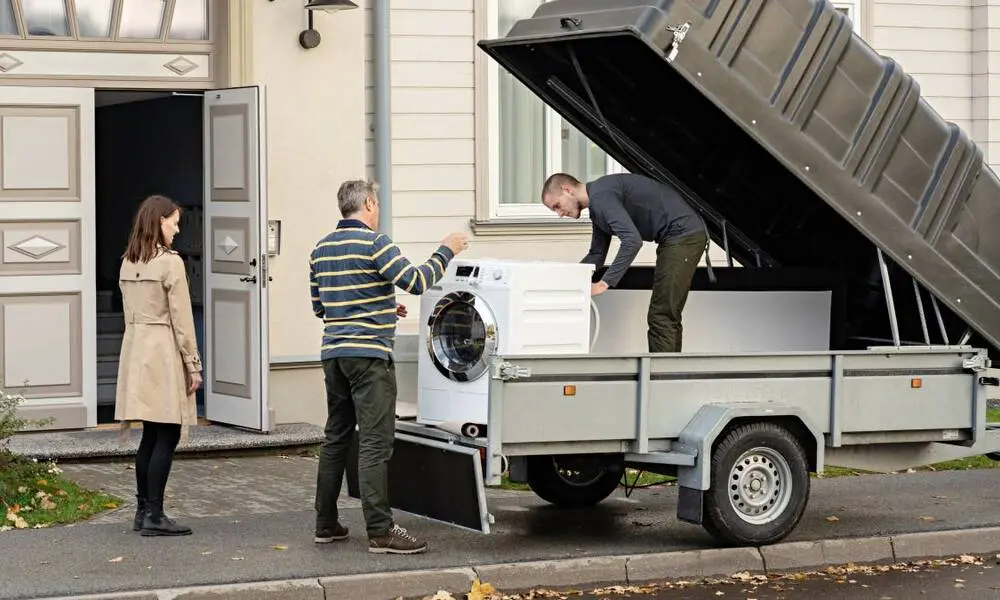How to move a washing machine starts with careful planning and attention to safety. Moving a washing machine is more complex than it seems due to its weight, hoses, and internal drum. If done improperly, it can lead to injuries, water damage, or a broken appliance. That’s why preparation is key to avoiding costly mistakes. Both your home and your machine can be protected by using the right tools and methods. Hiring professional washing machine movers is often the safest choice for a smooth move. Whether you’re doing it yourself or calling the pros, safety and planning should come first. Proper handling ensures your appliance stays in good working condition.
How to Get a Washing Machine Ready to Move

A washing machine must be moved carefully to prevent damage and mess. Here’s a little how-to to complete it safely:
1. Turn Off Power and Water
Unplug the machine and turn off the water supply. This prevents leaks and electrical hazards.
2. Drain All Water
Disconnect hoses and drain any remaining water from both the drum and the hoses. Use a shallow pan or bucket.
3. Clean and Dry the Drum
Wipe the inside of the washer and leave the door open to air dry. This stops mold from forming during the move.
4. Secure the Drum
Use transit bolts (if available) to lock the drum in place. This prevents internal damage while moving.
5. Tape Cords, Hoses, and Doors
Attach hoses and power cords securely to the washer’s body. To keep the door closed while being transported, use tape.
Bonus Tip: Know Your Washing Machine Weight
Most machines weigh between 150–200 lbs. To avoid getting hurt, always lift with assistance or use a dolly.
If you’re looking for reliable moving services in Sherman Oaks, we’re here to help. Contact us today for safe and professional assistance with your move!
Essential Items Needed to Move a Washing Machine
Moving a washing machine safely requires the right tools and equipment. The following are essentials to keep both you and your appliance safe during moving:
1. Moving Straps and Gloves
These help you lift and carry the washer with better grip and less strain.
2. Appliance Dolly or Trolley
A sturdy dolly is essential for moving a heavy washer across floors or down stairs. Most washing machine movers use one to prevent injuries.
3. Blankets or Padding
To protect your machine from dents and scratches while being transported, wrap it in moving blankets.
4. Wrench and Pliers
These are needed to disconnect water hoses and remove or attach transit bolts.
5. Transit Bolts (If Applicable)
Use transit bolts to lock the drum and protect internal parts during the move.
6. Waterproof Containers for Hoses
Keep disconnected hoses in waterproof bags or containers to prevent leaks and messes.
How to Move a Washing Machine in Seven Easy Steps
Whether you’re relocating across town or just changing apartments, knowing how to move a washing machine the right way can save you from damage, mess, or injury. Washing machines are bulky and heavy, but with the right steps, the process becomes safe and manageable.
Step 1: Disconnect the water supply and turn it off.
To get started, unplug the washing machine from the power source. Next, close the water supply valves, which are often found behind the washer. This stops water from flowing during the disconnection process.
Step 2: Drain All Water from the Machine
Before moving, it’s imperative to remove any leftover water:
- Disconnect the hot and cold water hoses.
- Let any remaining water drain into a bucket or shallow pan.
- Lower the drain hose to let out water from the machine’s pump system.
This prevents water from spilling during transport.
Step 3: Secure All Loose Parts and Wires
Use tape to secure the power cord to the washer’s rear. Coil the water hoses and place them in a waterproof bag. If your washer has a door, tape it shut using painter’s tape.
Also, insert transit bolts to lock the drum in place (if your machine requires them). These bolts prevent internal damage during the move.
Step 4: Use moving blankets to shield the washing machine.
Wrap the washer in thick moving blankets or padding. This protects it from dents, scratches, and bumps during loading and transport. Straps or packing tape can be used to fasten the padding.
Step 5: Lift Carefully Using a Trolley or Dolly
Washing machines are heavy often 150 to 200 pounds. Use an appliance dolly or trolley for safe lifting.
- Slide the dolly under the washer.
- Secure it with moving straps.
- Always keep the washer upright to avoid damaging the internal drum and suspension.
Step 6: Load into the Truck, Upright and Strapped
Use a ramp if possible and load the machine into the truck while keeping it upright.
- Position it against the truck wall.
- Strap it tightly to avoid movement during the drive.
Never lay a washing machine on its side or back, as it may damage internal components.
Step 7: Reinstall Carefully in the New Location
Once you arrive:
- Remove the transit bolts.
- Reconnect the water supply and power cord.
- Level the washer using the adjustable feet.
- Run a test cycle to ensure everything works as it should.
You may read about How To Move Bulky Kitchen Appliances?
How to Move a Washing Machine with a Trolley

Moving a washing machine can be tough because of its washing machine weight, which often ranges between 150 to 200 pounds. Using a trolley makes the process safer, easier, and more efficient.
Benefits of Using a Trolley to Move Washing Machine
- Stability: A trolley provides a steady base to keep the washer balanced while moving.
- Safety: It reduces the risk of back injuries and strain by handling most of the weight.
- Ease: Rolling the machine on wheels is much easier than carrying it, especially over longer distances or stairs.
Correct Technique to Lift and Load with a Trolley
- Prepare the Washing Machine:
Secure cords and hoses, tape the door shut, and drain any remaining water. - Position the Trolley:
Tilt the washing machine slightly and slide the trolley underneath its base. - Secure the Washer:
Use moving straps to tightly fasten the washing machine to the trolley to avoid slipping. - Lift Carefully:
Use proper lifting techniques bend your knees, keep your back straight, and lift with your legs. If possible, have two movers share the load. - Move Slowly:
Roll the washing machine smoothly to avoid tipping. Watch for obstacles and uneven surfaces.
Step-by-Step Trolley Use Guide for One or Two Movers
- For One Mover:
Use a strong appliance dolly with straps and a handle for better control. Tilt the washer back gently and secure it on the trolley. Move slowly and take breaks if needed. - For Two Movers:
One person guides and steadies the washing machine from the front, while the other pushes the trolley. Communicate clearly and move together, especially when navigating stairs or tight spaces.
Safety Precautions to Avoid Tipping or Slipping
- Always keep the washing machine upright never lay it flat.
- Make sure the straps are tight to prevent the washer from shifting.
- Wear gloves for better grip and protection.
- Check the path ahead for hazards like wet floors, loose rugs, or uneven steps.
- Move at a controlled pace to maintain balance.
Using a trolley is one of the best ways to move a washing machine safely, protecting both the appliance and yourself from injury. Remember, the heavy washing machine weight makes the right equipment and technique essential.
When to Require Professional Help to Move a Washing Machine
While a DIY move may seem manageable, there are situations where calling in professionals is the safest and smartest option especially when dealing with the heavy washing machine weight and potential property damage.
Situations When DIY Might Not Be Enough
- Stairs or Tight Spaces: Moving a washing machine upstairs or downstairs increases the risk of injury or damage without the right equipment.
- Long-Distance Moves: Long drives require proper loading and securing to keep your appliance safe in transit.
- Fragile Flooring: Wood, tile, or laminate floors can easily get scratched or cracked during DIY appliance moves.
- Lack of Tools or Manpower: Without a trolley, moving straps, or help from others, the task can become dangerous and exhausting.
Benefits of Hiring Professional Movers
- Experience & Safety: Trained movers know how to safely handle large appliances like washers.
- Proper Equipment: From dollies to padding, pros have the right gear to protect your home and appliances.
- Time-Saving: A professional team can move your washing machine quickly and with minimal disruption.
- Insurance Coverage: Most moving services offer liability protection for added peace of mind.
Cost vs. Risk: Is It Worth It?
While hiring movers comes with a fee, it often costs less than the potential damage to your washer, flooring, or back. Replacing a broken washing machine or repairing your floor is far more expensive than a one-time moving service.
Trust Chamomile Go for Safe Appliance Moving
At Chamomile Go, we specialize in moving heavy appliances like washing machines across Sherman Oaks and surrounding areas. Our team comes prepared with the tools, skills, and experience to get the job done right without damage, delays, or stress. Contact us today to schedule your hassle-free appliance move!
FAQs
Can I Move A Washing Machine By Myself?
Yes, but it’s not recommended unless you have the proper tools like a trolley and moving straps. Washing machines are heavy (often over 150 lbs), and moving one alone can risk injury or damage to the appliance and your floors.
Do I Need Transit Bolts To Move A Washing Machine?
Yes, transit bolts are essential for securing the drum during transport. Without them, internal components may get damaged. If you’ve lost them, check with the manufacturer or order replacements before moving.
How Do I Drain Water From A Washing Machine Before Moving It?
First, turn off the water supply. Then disconnect the hoses and place them in a bucket to drain. Lower the drain hose to the floor to release any leftover water inside the machine.
Can I Lay A Washing Machine On Its Side While Moving?
No, always keep the washing machine upright during transport. Laying it down can damage internal parts like the suspension or drum.
How Much Does A Washing Machine Weigh?
The washing machine weight typically ranges from 150 to 200 pounds, depending on the model and features. Always plan ahead with proper lifting equipment or help from others.








